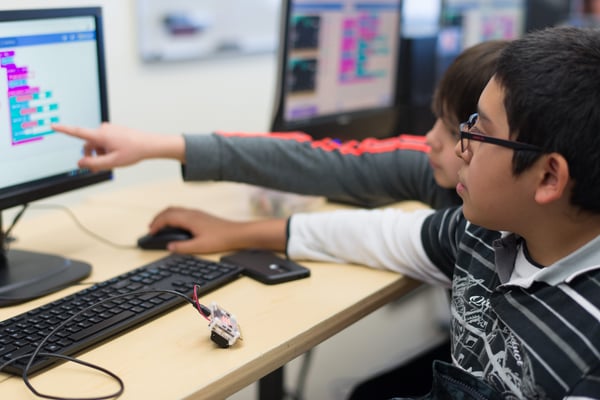The Covid-19 pandemic has left educators reeling and has thrown us into a new paradigm with our students. We have never been challenged to deliver quality education to each and every student as we are now, especially when it comes to STEAM, computer science and project-based learning.
For many of us, these topics have been relatively new to our pedagogy to begin with and now we are challenged to figure them out remotely, with our students at home with probably minimal tools and maybe even a lack of internet connection.
Now is the time to be bold and try new things. It is time to dig in WITH our students and solve this problem together. Let’s put ourselves out there and fail early and fail often when it comes to STEAM education at home.
 But where to start?
But where to start?
Let’s take a look at one option for keeping kids engaged with programming and STEAM education, the micro:bit. As our top recommendation for remote instruction, the micro:bit requires minimal setup, is straight forward when it comes to ease of use, and has a minimal cost when it comes to hardware
Cost and Hurdles
While the micro:bit is a piece of hardware that has a cost associated with it, they are cost effective when compared to other similar platforms. Many, if not all districts are scrambling when it comes to budget and, as a teacher, you may not even have access to your budget at the moment. We understand! But, this is an exploration of an option for you if and when you do have access to funds.
The major hurdles here are student access to a computer and internet. These are not small hurdles by any means. However, with school districts being forced to go remote, many are providing some sort of device, usually a Chromebook, for student use. This device can be used by students to program a micro:bit. (And, yes, micro:bits can be programmed on Chromebooks!)
In terms of internet access, many internet providers are working with school districts to connect students to their schools. If you feel that your students are missing access to the internet, check with your district, there are usually options available.
Teaching and Learning
Let’s assume that you have overcome the hurdles of getting micro:bits in the hands of your students.
Now, how do we go about using the micro:bits in a meaningful way? The school invested in these, now it is time to use them! How do you go about starting this journey on the right foot?
Well, if it was up to us, the journey would start with a brief introduction to the micro:bit to your students through a video by you that includes a transparent admission that this is going to be an experiment and something that you are all going to learn together. Introduce the parts of the micro:bit, what it is, and what you plan to do with it.
But what are you going to do with the micro:bit? Well, there is a whole world of content out there to explore. We have curated a number of videos to help get you and your students up and running. In terms of lessons, tutorials, projects and challenges for you and your students to tackle, the micro:bit foundation has worked to create a huge body of work you can find here.
If you are programming the micro:bit in Microsoft MakeCode many of the programming lessons and projects are baked into the home menu. You are one click away from guided lessons, video explanations and fun projects that can be done with just the micro:bit itself or with a few supplies that most people have around the home.
Instructional Platforms
Now that we have content and micro:bits, the question becomes: how do you teach this? What is the pedagogy here? While this is completely up to you and how you have already been teaching for the past few weeks, if you are still wondering what tools may be available for you, we have two recommendations that make teaching programming with micro:bits simpler and help maintain student engagement when frustration rears its ugly head.
(Synchronous) Direct Instruction Through micro:bit Classroom
The micro:bit foundation released a new tool for educators a few months ago, called micro:bit Classroom.
micro:bit Classroom is a tool that is safe to use with your students when it comes to online interactions and information safety. It is a tool that, in a remote classroom situation, enables you, as the teacher, to peer over your students’ shoulder, assess their learning and offer assistance when frustration is at its peak with learning how to code.
micro:bit Classroom is free to use, and is slick and easy when you want all of your students to be working simultaneously on something. Pairing micro:bit Classroom with another video conferencing tool, such as Google Meets or Zoom, enables you to give real time instruction to your students while also having the ability to facilitate 1:1 or small group instruction that seems almost impossible these days.
(Asynchronous) Indirect Instruction
We have all learned that our digital classrooms are not the same as our brick and mortar schools. We have to find new ways and new tools to connect with our students over the digital divide that is remote instruction. Teaching programming, even on the micro:bit, is something that is challenging on its own, especially when it comes to those first few steps. The path is littered with opportunities to lose our students to frustration and technical difficulties. We need to be there even when we can’t and that is the importance of a platform like Microsoft FlipGrid.

FlipGrid is essentially a video forum platform designed for the classroom. Where you, as a teacher, can post topics, questions and assignments via short videos by you accompanied by links, etc. Students can then respond with their own short videos where they can ask questions and literally show you issues or demonstrate a project they created. There is also a tool for you to give assessment and feedback on their projects.
We highly recommend FlipGrid if you aren’t using anything at the moment. We are currently using FlipGrid with our Professional Development and Webinar participants for extended Q&A long after the sessions are done. It’s been a great way to stay in touch with our instructors.
Upcoming Webinar
With all of this in mind and if you are interested in learning more about trying out this bold new idea with your students, we are hosting a free webinar. We hope you can join us and that we’ve inspired you to bring computer programming and STEAM to your students, even when they are at home.
Update: The recorded version of the webinar can be found below.




Professional Development, Events, teaching tools, announcement, getting started, micro:bit, helpful information, computer science, Training